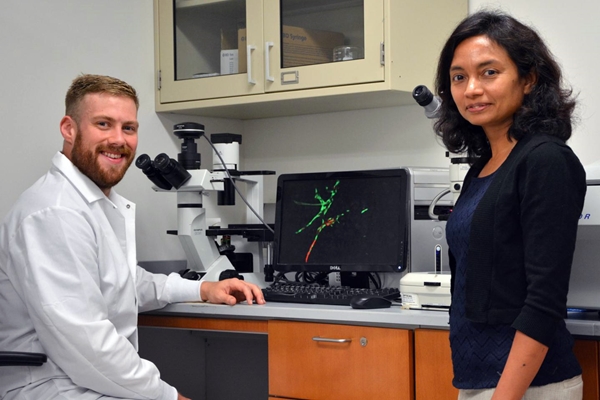
Ipsita Banerjee, right, with doctoral candidate Thomas Richardson (Paul Kovach, University of Pittsburgh)
24 August 2017. A team from three universities is developing in the lab synthetic islet cells, the cells that produce insulin in the pancreas, for eventual transplantation in people with type 1 diabetes. The three-year project, led by University of Pittsburgh chemical engineering professor Ipsita Banerjee, is funded initially by a National Science Foundation grant of $300,000.
The transplanting of pancreatic islet cells is considered a promising treatment for type 1 diabetes, but is stymied so far by the instability of islet cells grown from stem cells. Banerjee and associates at Arizona State University and University of Louisville are devising a different method of growing islet cells in the lab from human pluripotent stem cells, or hPSCs, that begin growing blood vessels while still in lab cultures, to improve their chance of survival after transplant.
Type 1 diabetes is an inherited autoimmune disorder where the body does not produce insulin, and is diagnosed primarily in children or young adults. Autoimmune disorders are conditions where the immune system is tricked into attacking healthy cells and tissue as if they were foreign invaders, in this case, insulin-producing islet cells in the pancreas. About 1.25 million people in the U.S. have type 1 diabetes, about 5 percent of people with diabetes of any kind.
Banerjee and colleagues plan to boost the stability of pancreatic islets grown from stem cells by beginning the development of islets in the lab to where the cells grow blood vessels as part of their transformation. The blood vessels support the increased need for oxygen and nutrients as the stem cells aggregate and transform into organoids, precursors to mature cells and tissue. The researchers are merging blood vessel fragments from adipose, or fat, tissue to start their growth in islets.
“This the first attempt to generate in vitro vascularized pancreatic islet organoids from hPSCs,” says Banerjee in a university statement. “By vascularizing the islets before they are transplanted to the body, they are more likely to survive and can begin regulating blood glucose more quickly.”
For a lab culture to develop the stem cells into organoids, the team is adapting a hydrogels, or water-based polymers, from the lab of bioengineering professor Kaushal Rege at Arizona State. The hydrogels simulate the environment in the pancreas to encourage the stem cells to transform into islet organoids. These organoids are expected to form into three-dimensional spheres, which more closely resemble actual islet cells than previous methods.
The team plans to first determine the best hydrogel mix for transforming stem cells into islet organoids, then grow islet organoids with micro-scale blood vessels from stem cells. The researchers also expect to test the ability of mature islet cells grown from organoids to respond to blood glucose levels and produce insulin under lab conditions as well as in mice.
Banerjee and colleagues believe the methods developed for growing blood vessels in organoids could be applied to other types of cells and tissues. “The principles behind pre-designing vascularization before transplantation,” she notes, “apply to any type of tissue, not just pancreatic.”
More from Science & Enterprise:
- 3-D Printing Process Developed for Living Tissue
- Gene-Edited Skin Grafts Shown to Control Glucose Levels
- Synthetic Beating Heart Repair Tissue Being Developed
- Stem Cell Parkinson’s Model Devised for Drug Screening
- Crispr, Stem Cells Produce Precise Arthritis Therapy
* * *

 RSS - Posts
RSS - Posts
You must be logged in to post a comment.